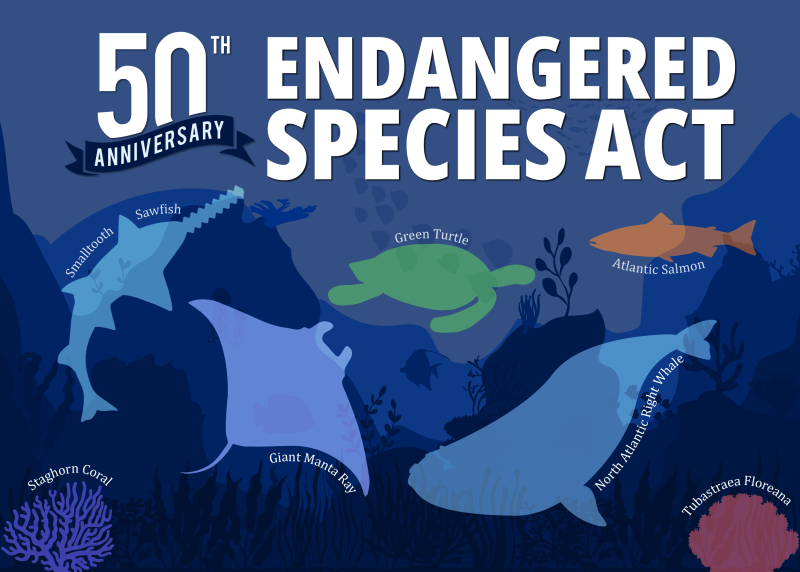
Celebrate the 50th anniversary of the Endangered Species Act by learning more about NOAA's work to conserve endangered species and their habitats.
Feature Story |
Join us in celebrating the 50th anniversary of the Endangered Species Act, May 19–December 28, 2023! This landmark legislation is a powerful and effective tool for conserving species and their habitats.
Under the Act, NOAA Fisheries is responsible for the protection, conservation, and recovery of more than 160 endangered and threatened marine and anadromous species . At NOAA Fisheries, we rely on the best available science to implement the ESA . During this monumental commemoration of 50 years, we highlight our science, conservation, partnerships, and people who implement the ESA through the features and videos below.
Follow along on our NOAA Fisheries social media channels and stay tuned for more content.
Learn about Rice’s whales—their population status, habitat, threats, and other frequently asked questions.
 Pleased to Announce a New Scientific Research Paper that Describes a New Species of Baleen Whale in the Gulf of Mexico" width="750" height="500" />
Pleased to Announce a New Scientific Research Paper that Describes a New Species of Baleen Whale in the Gulf of Mexico" width="750" height="500" />
Work in the Chesapeake Bay includes identifying and protecting habitat used by these fish for spawning, seeking to minimize vessel strikes, and educating students about these fish.

A look at successes and challenges faced by different green turtle populations.

Unpredictable weather patterns, warming ocean temperatures, and rising sea levels caused by climate change reduce available habitat for the endangered smalltooth sawfish.

Warming ocean temperatures and more intense storms caused by climate change are impacting prey availability and habitat quality for migratory sharks and rays, keystone species in the ocean.

As we celebrate the 50th anniversary of the Endangered Species Act, we are shining a spotlight on our recovery efforts to reduce bycatch to protect and conserve sea turtles.

NOAA Fisheries and the U.S. Fish and Wildlife Service are proposing a series of revisions to the joint regulations that guide their implementation of this landmark statute.

In celebration of the Endangered Species Act’s 50th Anniversary, NOAA is featuring the marine mammal and sea turtle species found in Alaska that are protected under the ESA.

Removed from the Endangered Species List in 2013, the eastern distinct population segment of the Steller sea lion is still recovered a decade later.

Celebrate the 50th anniversary of the Endangered Species Act by getting to know some of the threatened and endangered species found in the waters of the southeastern United States.
Experts meet to celebrate smalltooth sawfish and talk about the future of the species.

Marking the 50th year of the passage of the Endangered Species Act, we are shining a spotlight on the biologists and partnerships saving Pacific leatherback sea turtles from extinction.

Marking the 50th year of the passage of the Endangered Species Act, we are shining a spotlight on the biologists and partnerships saving Sacramento River winter-run Chinook Salmon from extinction.

Marking the 50th year of the passage of the Endangered Species Act, we are shining a spotlight on the biologists and partnerships saving Southern Resident killer whales from extinction.

Climate-driven changes such as higher ocean temperatures and extreme weather events are affecting the health of marine animals—and their ability to survive.
Marking the 50th year of the passage of the Endangered Species Act, we are shining a spotlight on the biologists and partnerships saving Central California Coast coho from extinction.

Marking the 50th year of the passage of the Endangered Species Act, we are shining a spotlight on the biologists and partnerships saving white abalone from extinction.

NOAA Fisheries Assistant Administrator Janet Coit discusses how the Endangered Species Act is a powerful and effective tool for conserving species and their habitats.

Listen in! NOAA Fisheries Assistant Administrator Janet Coit celebrates 50 years of the Endangered Species Act and discusses why it is such a foundational law.

Of all the species NOAA Fisheries protects under the Endangered Species Act, we consider nine among the most at risk of extinction in the near future.
To implement the Endangered Species Act, we rely on the best available science. We work with international federal, tribal, state, and local agencies, as well as nongovernmental organizations and private citizens.
The Endangered Species Act continues to be a powerful and effective tool for conserving species and their habitats. Less than 1 percent of the species listed under the ESA have gone extinct. Others have been recovered to the point where they no longer need protections under the ESA.
